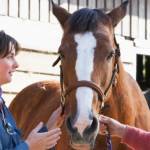Basic Neurologic Examination for Horses

Your older gelding has been acting a little strange, occasionally stumbling or seeming to be somewhat uncoordinated as he moves. You call your veterinarian, who suggests that a neurologic examination might be a good idea. What can you expect when the veterinarian arrives? What can she learn about the inside of your horse by examining the outside? There’s actually a lot to find out, even before she touches the horse.
First, the horse will be observed in his own stall or a small turnout area. In familiar surroundings, the horse should be relaxed but should notice people and things around him. Anything new, such as an unfamiliar person or sound, should get a reaction from the horse even if it’s only a small movement of the head or ears. An overreaction, such as unnatural panic without an appropriate stimulus, could be a sign of neurologic problems. Total disinterest in novel objects or sounds could also signify a problem.
Even if the horse isn’t moving, his stance can indicate whether his nervous system is working correctly. He may stand with either rear leg relaxed but otherwise should be bearing weight squarely, with all legs correctly positioned under his body. His head should be carried normally, not tilted to one side or held in an odd position. Muscling should be symmetrical on both sides of the body including the face, neck, forehand, and hindquarters, and should not show atrophied areas.
A closer examination of the horse’s face and head can help in the diagnosis of neurologic problems. If a hand is moved suddenly toward the horse’s eye from any direction, he should respond by blinking. Neurologic impairment could be suspected if a horse has a drooping ear or eyelid, poor ability in chewing or swallowing, a slow or absent reaction of the eye pupil to light, or a lack of sensitivity around the mouth, eyelids, nostrils, or ears.
After the veterinarian has examined the horse at rest, she will want to see him in motion. A freely moving horse that walks in circles, runs into trees or fences, or stands with his head pressed against a wall or other solid object is showing signs of a neurologic problem. When led, the horse should be able to walk and trot, negotiate turns with good coordination, and step up and down a curb or slope without difficulty. If the horse is pushed sideways as he walks, he should be able to accommodate the force without staggering or falling. Horses with neurologic conditions may not move well because they aren’t always sure where their legs are or how to stay balanced. They may swing their legs too widely while turning or drag their hooves as they walk, wearing the toes to a flattened shape.
Based on the results of this examination, the veterinarian may be able to diagnose the horse’s neurologic condition, though further tests may be necessary to pinpoint the cause of the problem.








